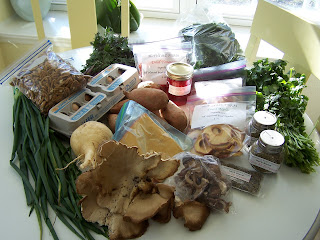But there is good news too! We found milk, butter, and heavy whipping cream over the weekend. On Sunday, our lovely friend Dawn brought us a bag of local rice - our only food at that point in the grains and cereals category. Coincidentally, on Saturday evening, I had heard about the farmer who grows rice and kiwis (yes, kiwis) in Morganton, NC. Thanks to Dawn, we did not have to drive to Morganton. Instead we discovered that his rice is sold locally at the historic Atherton Mill and Market on Joselle's route to and from school. Since the Atherton Market is open three days per week, Joselle stopped in on Tuesday for more rice. And guess what my Valentine scored - greenhouse tomatoes from Mt. Pleasant and Albemarle, frozen blackberries from Hendersonville, and huge bags of dried apple slices from Moravian Falls. Before the discovery of the frozen blackberries, dried apple slices were the only fruit we had found, and we had been rationing them!
Joselle even found cornmeal at Atherton Market, which I was suspicious about at first. Local cornmeal exists but is not easy to identify, because there is often a geographic difference between where it is milled and where it is grown. The cornmeal she found was milled in Oak Ridge at the Old Mill of Guilford, which does fall within the 100 mile radius. So I called them and was pleased to discover that it is grown in Boonville, which is also within 100 miles of Charlotte! I have learned to ask lots of questions as we have been led astray on more than one occasion so far.
 |
| Some of This Weekend's Booty |
 |
| Local Eggs and Dried Apple Slices |
Our favorite meal so far was probably dinner last night. We used our blackberries in combination with milk, honey, pecans, ice, and a little heavy whipping cream to make smoothies! They were a little seedy but really good. Joselle also was gracious enough to whip up some cornbread while I was at work. Though the cornbread lacked the recommended salt and baking soda, we didn't notice. We just slathered it in butter and honey! We also had baked purple sweet potatoes with butter, honey, and pecans. It felt like a small, but important victory.
 |
| Blackberry Smoothie, Cornbread, & Purple Sweet Potato |
Well, that's the skinny so far. Speaking of skinny, I lost 2.5 pounds in first two days. We really have not been eating enough calories, but we also have not been particularly hungry. I have also not been especially tempted by other foods. This is probably because I am mostly at home, where we have limited temptations. However, our dogs did return home from daycare on Valentine's Day with a bag of dog biscuits and candy for us - chocolates and gummy worms (the sweet and sour type). The candy smelled so good. My mouth is watering thinking of it...


